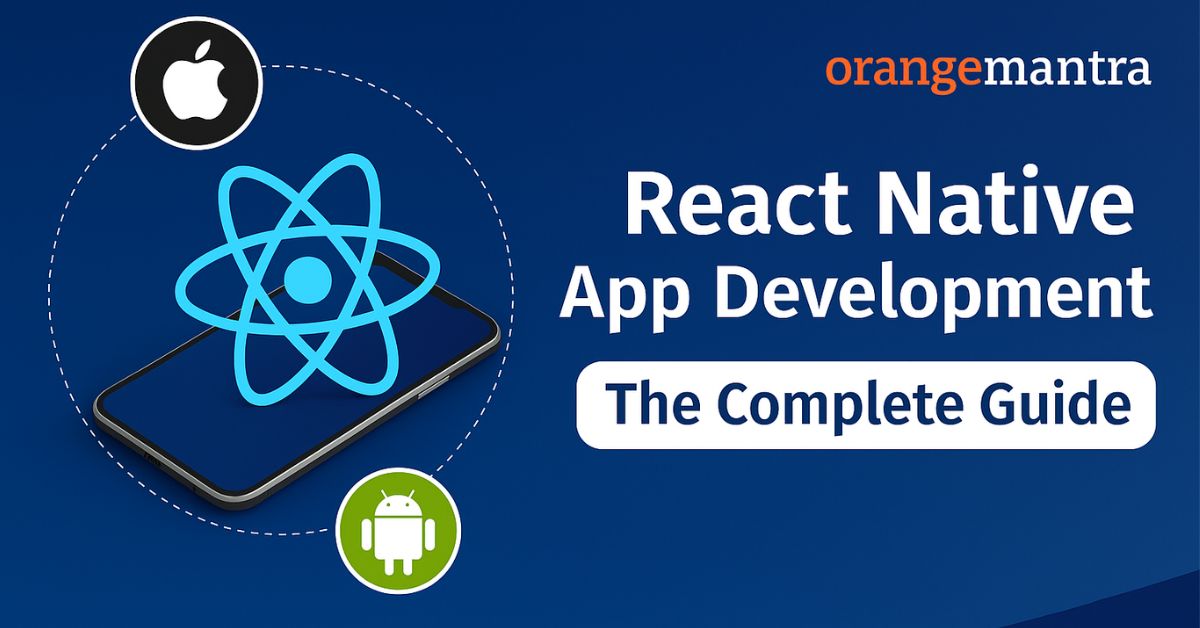
How React Native helps businesses build cross-platform apps faster and Affordable, a step-by-step development guide, cost breakdown in India, best practices, and how to choose the right React Native partner.
Every business today wants to stay on their customer’s phone with apps that feel natural, fast, and engaging. But building for both iOS and Android usually means double the work and higher costs. This is where a React Native app development company can help—delivering cross-platform apps with a single codebase.
But what if you could deliver to both? That too without doing everything twice. That’s the promise of React Native app development.
Table of Contents
The Real Reason Brands Are Betting on React Native
When Facebook first introduced React Native, they weren’t just solving a developer problem—they solved a business problem: how to build apps faster, cheaper, and without sacrificing performance. Today, brands hire React Native mobile app developers for the same reason—speed to market with native-like quality.
With React Native mobile app development, you don’t need two teams writing two versions of the same app. You don’t need months of delays to roll out a simple update. You don’t need to sacrifice performance just to save a buck.
6 Step-by-Step Guide to Build a React Native App
So, you’re convinced React Native is worth it. But how do you actually go from idea to a working app? Here comes the good news—it’s simpler than most people think. Let’s check how to use this quick guide to start your first React Native app project that serves a roadmap to get your first React Native mobile app.
1. Set up the environment
Get started by installing Node.js, React Native CLI, and Android/iOS tools.
2. Create a new project
Run npx react-native init AppName to start fresh.
3. Build UI components
Use reusable components for screens, buttons, and layouts.
4. Add logic & APIs
Connect your app to backend services with REST or GraphQL.
5. Test & debug
Run on simulators/devices, fix errors, and optimize performance.
6. Launch & update
Publish to App Store/Google Play and push updates with ease.
The Business Case for React Native
Customers don’t care if your app is native or cross-platform—they care about speed, design, and reliability. That’s why businesses increasingly choose cross-platform frameworks like React Native. A JavaScript-based mobile app built with React Native combines cost savings with a native-like user experience.
With React Native, you can:
Launch Faster Than Competitors
You already know that it’s possible to write once and deploy everywhere. You save a lot of time by not writing everything twice. React Native has a shared codebase it saves development time compared to building separate native apps.
Save Money and Keep Quality
Achieve high-quality results with fewer developers, less code duplication, and lower maintenance demands. Update and bug fixes roll out simultaneously on both platforms.
Build Apps That Feel Truly Native
React Native differs from older hybrid framework as now, React Native renders actual native UI components instead of web views. So, this only means smoother navigation, better animations, and higher user satisfaction.
Update in Real-Time with Hot Reloading
Developers can see changes instantly without recompiling the entire project. Faster iterations = faster innovation.
Tap Into Native Performance
For more complex features, React Native supports native code. When deeper OS integration is needed advanced say camera, GPS, or AR you can dive into native code as React Native allows native code usage without compromising performance.
Leverage a Massive Ecosystem
React Native being a great framework, hands you the keys to a mature ecosystem. You will find React Native CLI to libraries like React Navigation, Redux, and Reanimated. Think React Navigation, Redux, Reanimated—has your back, thanks to Meta and millions of contributors.
That’s why React Native’s quietly winning over startups and enterprises—it’s faster, cheaper, and still feels like the real deal and since most users want native-like user experience, they have it and now you know why it is quietly becoming the default choice for brands that want to scale without stumbling.
React Native Best Practices Nobody Tells You About
Anyone can write code. But building a mobile app that people actually love? That takes discipline. Here are a few best practices that great teams follow:
Think Modular with React Native Components
Don’t write code for today, write code that survives tomorrow. Break features into reusable React Native components. Follow a folder structure (atoms, molecules, organisms) that makes scaling easier. Use TypeScript that turns invisible bugs into visible ones before they spread.
Respect Platform-Specific Design for iOS & Android
If your app feels like an iPhone clone on Android, or vice versa—you’ve already lost. Give your users a native feel, iOS users expect smooth gestures whereas Android users expect Material Design elements like floating action buttons, ripple effects, and back button behavior. When an app looks or behaves differently, it feels off to them.
So, use Platform-specific APIs (Platform.OS) and conditional styling to give each user a native-like experience.
Be Lean with Libraries
Yes, that GitHub package looks great and promising. but build with long-term in mind.its better to stick to well-documented, community-backed libraries because two years from now. In the future you will appreciate maintainability. Use native modules only when absolutely necessary. And keep dependencies minimal to prevent bundle bloat.
Test Thoroughly with React Native Tools
It just takes one crash to lose hundreds of users. Use Jest and React Native Testing Library for unit tests. Automated integration tests with Detox or Appium. Don’t skip performance testing—tools like Flipper help monitor memory leaks, network calls, and UI responsiveness before your users do.
Hire Expert React Native Mobile App Developers
A great React Native mobile app developer is a great strategic product thinker. They master state management tools like Redux or Recoil, expertly manage offline-first data synchronization and know how to handle offline-first data sync, and can optimize bridge performance between JavaScript and native modules.
The difference between a good app and a great one? A commitment to meticulous details—architecture, testing, and user experience. They just craft the best apps expertly.
When You Should Choose React Native App Development?
For graphics-intensive 3D games, high-performance AR/VR apps, or projects requiring deep OS-level customization, native development often remains the best choice or even better, for something that needs deep OS-level customizations, native development may still be the safer route.
But for 80% of business apps, React Native mobile development isn’t just sufficient—it’s ideal. Here’s why:
- E-commerce & Retail – Faster launches, smooth shopping experiences, and easier feature rollouts across iOS and Android.
- On-Demand & Delivery Apps – Real-time tracking, notifications, and seamless UI without the cost of building twice.
- Social & Community Platforms – Reusable components speed up development of feeds, chat, and notifications.
- Fintech & Banking – Secure, scalable apps with integrations into APIs, while keeping costs lean.
- Healthcare & Fitness –Quickly prototype patient portals, integrate wearables, and build telehealth solutions—with React Native helping you move fast and stay flexible.
Put simply: if speed, efficiency, and cross-platform scale matter to you, React Native is the solution. Because nobody wants to compromise with speed.
React Native App Development Cost in India: A Complete Breakdown
Hiring a React Native app development company in India can cost anywhere from ₹1,00,000 for basic apps to over ₹1 crore for enterprise-grade mobile solutions. The cost depends on features, complexity, and the expertise of React Native mobile app developers you hire.
| App Complexity | Features Included | Estimated Cost (₹) | Development Time |
| Basic App | Simple UI, few screens, basic API integration (e.g., calculator, note-taking, event tracker) | ₹1,00,000 – ₹5,00,000 | 1–3 months |
| Medium App | Custom UI/UX, payment gateways, push notifications, API integrations, offline access | ₹5,00,000 – ₹15,00,000 | 3–6 months |
| Complex App | Advanced features (real-time chat, geolocation, video streaming, AR/VR), complex backend | ₹15,00,000 – ₹60,00,000 | 6–12 months |
| Enterprise App | High scalability, custom architecture, multi-role dashboards, AI/ML integration | ₹60,00,000 – ₹1.25 Crore+ | 9–18 months |
Choosing the Right React Native Partner
The success of cross-platform app development with React Native depends less on the framework and more on your development partner. Look for a React Native app development company in India that has proven case studies, skilled developers, and the ability to scale your app for future needs.
The right partner will:
- Show proof they’ve done it before.
- Care about user experience as much as code.
- Future-proof your app, not just ship it.
The wrong one? They’ll just deliver “an app.” And that’s not what you’re here for.
Conclusion
The market doesn’t wait, and neither do users. Choosing the right React Native mobile app developers today means faster launches, lower costs, and apps that truly feel native. If you’re exploring cross-platform app development with React Native, now is the time to act.
FAQs:
Q1. Is React Native slower than Flutter for mobile app development?
Not necessarily. React Native delivers near-native performance, and for most business apps, the speed difference is negligible. What matters more is developer ecosystem, stability, and access to third-party libraries—where React Native still has an edge.
Q2. Can React Native mobile apps run on the web too?
Yes, with React Native for Web, you can extend your codebase to run on browsers too. It’s not always a drop-in replacement, but for shared UI components and business logic, it can save massive development time.
Q3. Is Flutter replacing React Native as a cross-platform framework?
No. Flutter app development is growing fast, but React Native still powers apps from Facebook, Shopify, and Tesla. With Meta’s backing and a huge community, React Native isn’t going anywhere—it’s evolving, not fading.
Q4. What is the hourly rate for React Native mobile app developers in India?
The hourly rate for a React Native mobile app developer in India usually ranges between $20–$50/hour (₹1,600–₹4,000/hour). Rates depend on experience, project complexity, and whether you hire freelancers or top-tier agencies.




